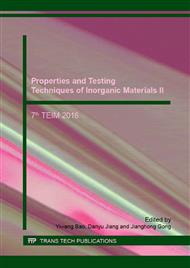p.434
p.440
p.445
p.450
p.455
p.460
p.465
p.470
p.481
Effects of Matrix Densification Based on Particle Packing on Lightweight Al2O3-MgO Castables
Abstract:
The property of refractory matrix was dominated by both the maineral composition and particle packing behaviors. In this study, the theoretical packing density of refractory castables was calculated to design the particle size distribution (PSD) of its matrix. Four lightweight Al2O3-MgO castables with different matrix PSD (represented by q-value) were prepared and examined. Results show that a suitable q-value was needed to ensure acceptable properties including sintering characteristics, strength and slag resistance, which deteriorated distinctly at high q ( > 0.31). For the sample with q = 0.28, the matrix showed dense and uniform mirostructure, and the properties of castable reached a favorable compromise among sintering characteristics (apparent porosity = 14.8%, bulk density = 3.02g∙cm-3, permanent linear change < 0.6%), strength (cold modulus of rapture = 12.4MPa, cold crashing strength=155.5MPa), and resistance against both slag corrosion (Ic = 22.4%) and penetration (Ip = 11.5%). The sample with q = 0.25 showed the highest strength and resistance against slag corrosion, but its slag penetration resistance was lower due to the existence of cracks between aggregates and matrix.
Info:
Periodical:
Pages:
455-459
Citation:
Online since:
January 2017
Authors:
Price:
Сopyright:
© 2017 Trans Tech Publications Ltd. All Rights Reserved
Share:
Citation:


